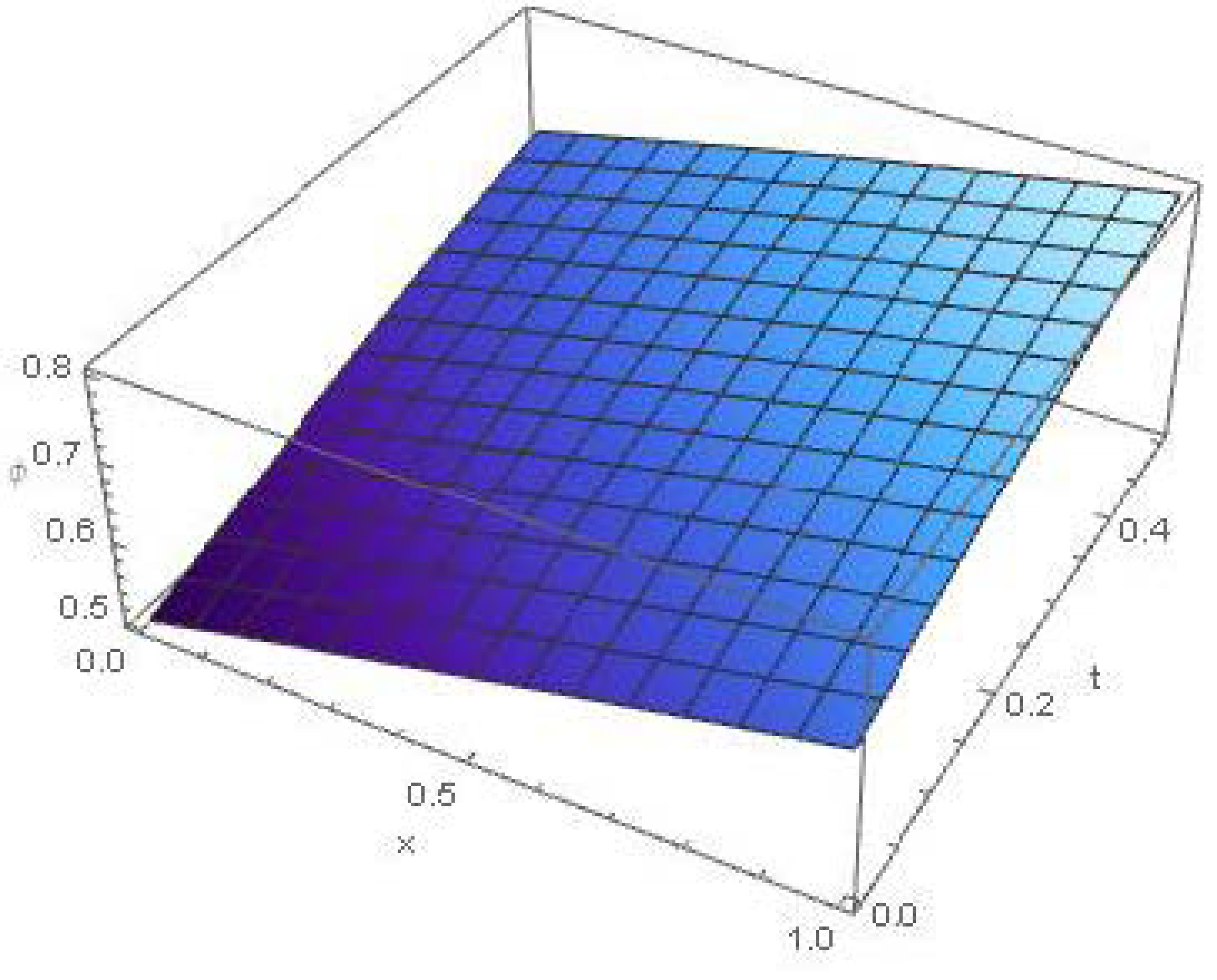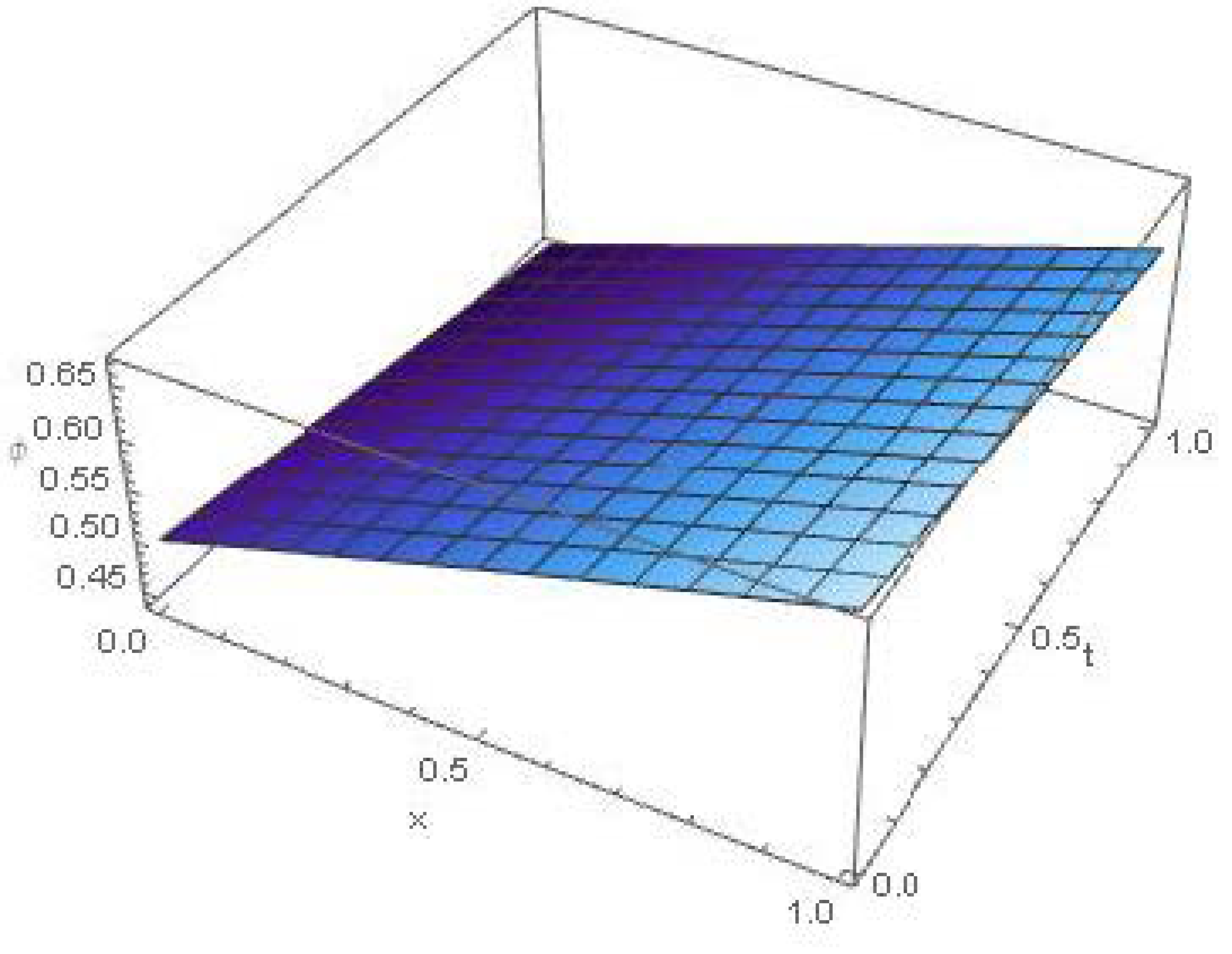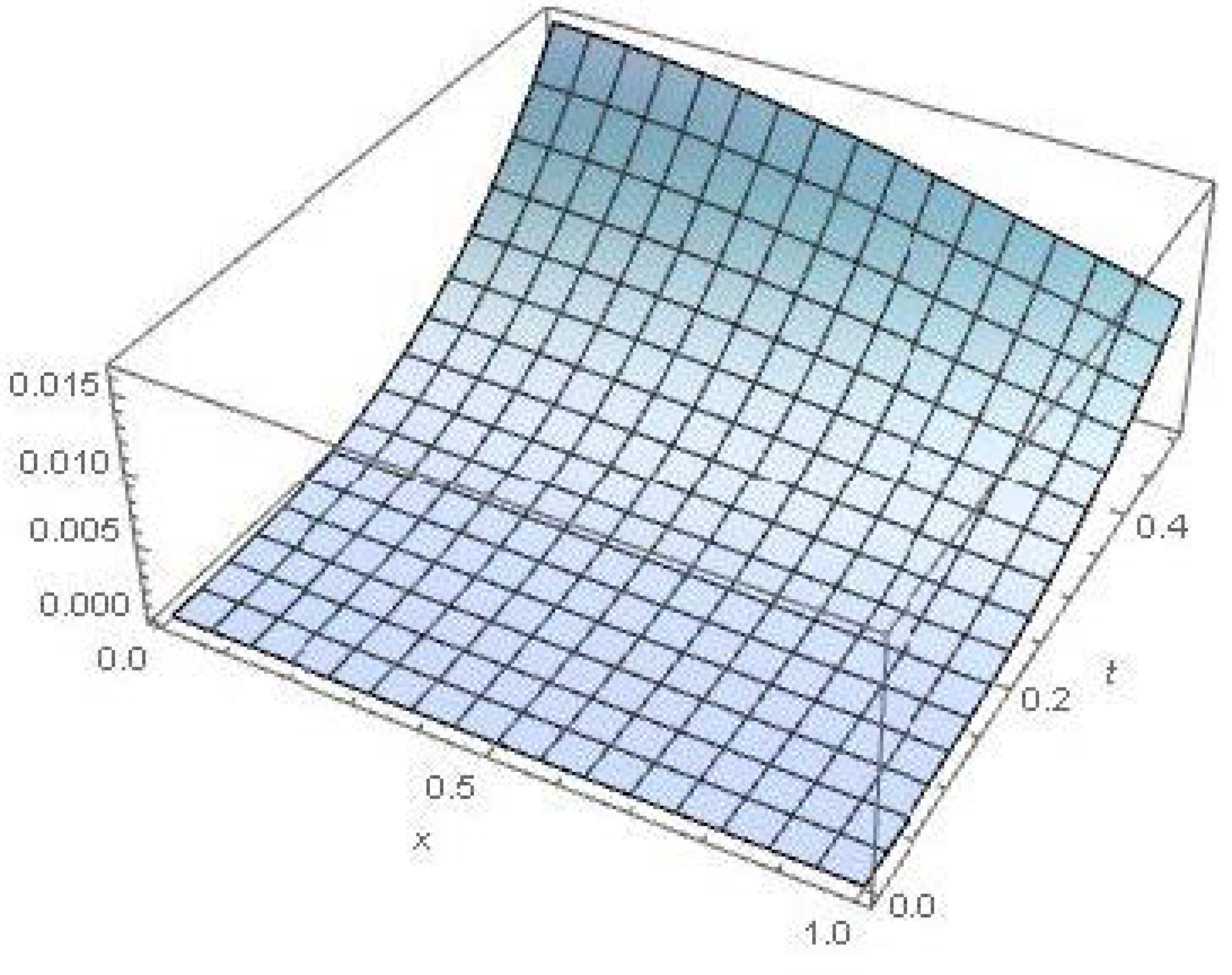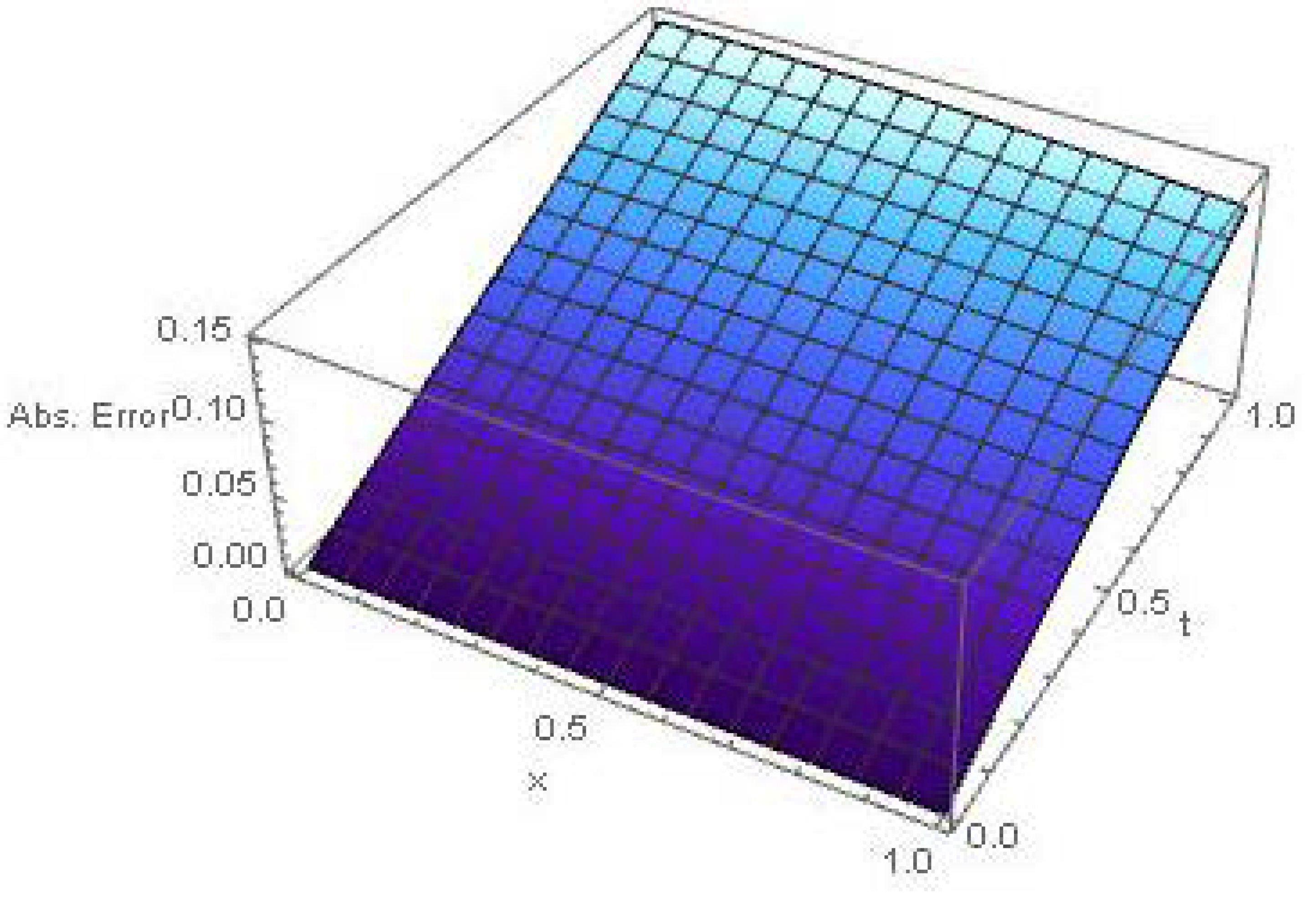On Convergence Analysis and Analytical Solutions of the Conformable Fractional Fitzhugh–Nagumo Model Using the Conformable Sumudu Decomposition Method
Abstract
:1. Introduction
2. Preliminaries
- 1.
- 2.
- 3.
- 4.
- 5.
- 1.
- 2.
- 3.
- 4.
- 5.
3. Analysis of (CSDM)
4. Convergence Analysis
5. Numerical Examples
6. Results and Discussion
7. Conclusions
Author Contributions
Funding
Institutional Review Board Statement
Informed Consent Statement
Data Availability Statement
Conflicts of Interest
References
- Debnath, L. Recent applications of fractional calculus to science and engineering. Int. J. Math. Math. Sci. 2003, 54, 3413–3442. [Google Scholar] [CrossRef] [Green Version]
- Shi, R.; Ren, J.; Wang, C. Analysis of a fractional order mathematical model for tuberculosis with optimal control. J. Nonlinear Funct Anal. 2020, 2020. [Google Scholar] [CrossRef]
- Cernea, A. On the mild solutions of a class of second-order integro-differential inclusions. J. Nonlinear Var. Anal. 2019, 3, 247–256. [Google Scholar]
- Kamenskii, M.; Voskovskaya, N.; Zvereva, M. On periodic oscillations of some points of a string with a nonlinear boundary condition. Appl. Set-Valued Anal. Optim. 2020, 2, 35–48. [Google Scholar]
- Fitzhugh, R. Impulse and physiological states in models of nerve membrane. Biophys. J. 1961, 1, 445–466. [Google Scholar] [CrossRef] [Green Version]
- Nagumo, J.S.; Arimoto, S.; Yoshizawa, S. An active pulse transmission line simulating nerve. Proc. IRE 1962, 50, 2061–2070. [Google Scholar] [CrossRef]
- Shih, M.; Momoniat, E.; Mahomed, F.M. Approximate conditional symmetries and approximate solutions of the perturbed Fitzhugh–Nagumo equation. J. Math. Phys 2005, 46, 023503. [Google Scholar] [CrossRef]
- Abbasbandy, S. Soliton solutions for the Fitzhugh–Nagumo equation with the homotopy analysis method. Appl. Math. Model. 2008, 32, 2706–2714. [Google Scholar] [CrossRef]
- Li, H.; Guo, Y. New exact solutions to the Fitzhugh–Nagumo equation. Appl. Math. Comput. 2006, 180, 524–528. [Google Scholar] [CrossRef]
- Hariharan, G.; Kannan, K. Haar wavelet method for solving FitzHugh-Nagumo equation. Int. J. Comput. Math. Sci. 2010, 2, 2. [Google Scholar]
- Kawahara, T.; Tanaka, M. Interaction of travelling fronts: An exact solution of a nonlinear diffusion equation. Phys. Lett. A 1983, 97, 311–314. [Google Scholar] [CrossRef]
- Nucci, M.C.; Clarkson, P.A. The nonclassical method is more general than the direct method for symmetry reductions: An example ofthe FitzhughNagumo equation. Phys. Lett. A 1992, 164, 49–56. [Google Scholar] [CrossRef]
- Soliman, A.A. Numerical simulation of the Fitzhugh- Nagumo equations. Abstr. Appl. Anal. 2012, 2012, 762516. [Google Scholar] [CrossRef]
- Hariharan, G.; Rajaraman, R. Two reliable wavelet methods to Fitzhugh-Nagumo (FN) and fractional FN equations. J. Math. Chem. 2013, 51, 2432–2454. [Google Scholar] [CrossRef]
- Kumar, D.; Singh, J.; Baleanu, D. A new numerical algorithm for fractional Fitzhugh– Nagumo equation arising in transmission of nerve impulses. Nonlinear Dyn. 2018, 91, 307–317. [Google Scholar] [CrossRef]
- Bu, W.; Tang, Y.; Wu, Y.; Yang, J. Crank–Nicolson ADI Galerkin finite element method for two-dimensional fractional FitzHugh–Nagumo monodomain model. Appl. Math. Comput. 2015, 257, 355–364. [Google Scholar] [CrossRef]
- Pandir, Y.; Tandogan, Y. Exact Solutions of the Time-fractional Fitzhugh-Nagumo Equation. AIP Conf. Proc. 2013, 1558, 1919–1922. [Google Scholar] [CrossRef]
- Olmos, D.; Shizgal, B.D. Pseudospectral method of solution of the Fitzhugh–Nagumo equation. Math. Comput. Simul. 2009, 79, 2258–2278. [Google Scholar] [CrossRef]
- Ghosh, U.; Sarkar, M.; Shantanu, D. Solution of linear fractional non-homogeneous differential equations with Jumarie fractional derivative and evaluation of particular integral. Am. J. Math. Anal. 2015, 3, 54–64. [Google Scholar]
- Wang, L.; Fu, J. Non-Noether symmetries of Hamiltonian systems with conformable fractional derivatives. Chin. Phys. B 2016, 25, 4501. [Google Scholar] [CrossRef]
- Kareem, A. Conformable fractional derivatives and it is applications for solving fractional differential equations. IOSR J. Math. 2017, 13, 81–87. [Google Scholar] [CrossRef]
- Adomian, G. A Review of the Decomposition Method in Applied Mathematics. J. Math. Anal. Appl. 1998, 135, 501–544. [Google Scholar] [CrossRef] [Green Version]
- Al-Zhour, Z.; Alrawajeh, F.; Al-Mutairi, N. New Results on the Conformable Fractional Sumudu Transform: Theories and Applications. Int. J. Anal. Appl. 2019, 17, 1019–1033. [Google Scholar]
- Abdeljawad, T. On conformable fractional calculus. J. Comput. Appl. Math. 2015, 279, 57–66. [Google Scholar] [CrossRef]
- Atangana, A.; Baleanu, D.; Alsaedi, A. New properties of conformable derivative. Open Math. 2015, 13, 889. [Google Scholar] [CrossRef]
- Khalil, R.; Al Horani, M.; Yousef, A.; Sababheh, M. A new definition of fractional derivative. J. Comput. Appl. Math. 2014, 264, 65–70. [Google Scholar] [CrossRef]
- Atangana, A. Derivative with a New Parameter: Theory, Methods and Applications; Academic Press: Cambridge, MA, USA, 2015. [Google Scholar]
- Afaqeih, S.; Bakıcıerler, G.; Mısırlı, E. Conformable Double Sumudu Transform with Applications. J. Appl. Comput. Mech. 2021, 1–9. [Google Scholar] [CrossRef]
- Alfaqeih, S.; Misirli, E. Conformable Double Laplace Transform Method for Solving Conformable Fractional Partial Differential Equations. Comput. Methods Differ. Equ. 2021. [Google Scholar] [CrossRef]
- Alfaqeih, S.; Misirli, E. On double Shehu transform and its properties with applications. Int. J. Anal. Appl. 2020, 18, 381–395. [Google Scholar]
- Alfaqeih, S.; Kayijuka, I. Solving System of Conformable Fractional Differential Equations by Conformable Double Laplace Decomposition Method. J. Part. Differ. Equ. 2020, 33, 275–290. [Google Scholar]
- El-Kalla, I. Convergence of the Adomian method applied to a class of nonlinear integral equations. Appl. Math. Lett. 2008, 21, 372–376. [Google Scholar] [CrossRef] [Green Version]
- Eltayeb, H.; Abdalla, Y.T.; Bachar, I.; Khabir, M.H. Fractional Telegraph Equation and Its Solution by Natural Transform Decomposition Method. Symmetry 2019, 11, 334. [Google Scholar] [CrossRef] [Green Version]








| t | x | Approximate Solution | Exact Solution | Absolute Error |
|---|---|---|---|---|
| 0.02 | 0.05 | 0.516332 | 0.516333 | 0.00000111929 |
| 0.10 | 0.525155 | 0.525156 | 0.00000111497 | |
| 0.15 | 0.533963 | 0.533964 | 0.00000110789 | |
| 0.20 | 0.54275 | 0.542751 | 0.00000109809 | |
| 0.25 | 0.55151 | 0.551511 | 0.00000108563 | |
| 0.07 | 0.05 | 0.534984 | 0.535031 | 0.0000475469 |
| 0.10 | 0.543768 | 0.543815 | 0.0000473493 | |
| 0.15 | 0.552524 | 0.552571 | 0.0000470361 | |
| 0.20 | 0.561249 | 0.561295 | 0.0000466091 | |
| 0.25 | 0.569936 | 0.569982 | 0.0000460706 | |
| 0.30 | 0.57858 | 0.578625 | 0.0000454232 |
| t | x | Approximate Solution | Exact Solution | Absolute Error |
|---|---|---|---|---|
| 0.05 | 0.505714 | 0.513255 | 0.00748392 | |
| 0.10 | 0.514549 | 0.522083 | 0.0075053 | |
| 0.01 | 0.15 | 0.523374 | 0.530897 | 0.00752205 |
| 0.20 | 0.532186 | 0.539691 | 0.00753415 | |
| 0.25 | 0.540977 | 0.548461 | 0.00754156 | |
| 0.05 | 0.505714 | 0.513255 | 0.00748392 | |
| 0.10 | 0.514549 | 0.522083 | 0.0075053 | |
| 0.05 | 0.15 | 0.523374 | 0.530897 | 0.00752205 |
| 0.20 | 0.532186 | 0.539691 | 0.00753415 | |
| 0.25 | 0.540977 | 0.548461 | 0.00754156 |
Publisher’s Note: MDPI stays neutral with regard to jurisdictional claims in published maps and institutional affiliations. |
© 2021 by the authors. Licensee MDPI, Basel, Switzerland. This article is an open access article distributed under the terms and conditions of the Creative Commons Attribution (CC BY) license (http://creativecommons.org/licenses/by/4.0/).
Share and Cite
Alfaqeih, S.; Mısırlı, E. On Convergence Analysis and Analytical Solutions of the Conformable Fractional Fitzhugh–Nagumo Model Using the Conformable Sumudu Decomposition Method. Symmetry 2021, 13, 243. https://doi.org/10.3390/sym13020243
Alfaqeih S, Mısırlı E. On Convergence Analysis and Analytical Solutions of the Conformable Fractional Fitzhugh–Nagumo Model Using the Conformable Sumudu Decomposition Method. Symmetry. 2021; 13(2):243. https://doi.org/10.3390/sym13020243
Chicago/Turabian StyleAlfaqeih, Suliman, and Emine Mısırlı. 2021. "On Convergence Analysis and Analytical Solutions of the Conformable Fractional Fitzhugh–Nagumo Model Using the Conformable Sumudu Decomposition Method" Symmetry 13, no. 2: 243. https://doi.org/10.3390/sym13020243






